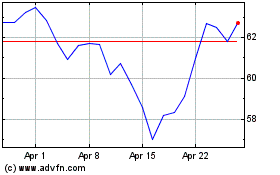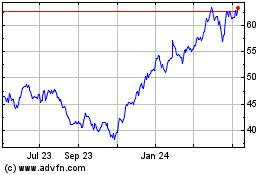Oil Prices Rally
August 31 2015 - 12:50PM
Dow Jones News
Oil prices turned higher Monday as traders digested a downward
revision in U.S. oil-production data, an article released by the
Organization of the Petroleum Exporting Countries and a drop in
Canadian output.
Light, sweet crude for October delivery rose $2, or 4.4%, to
$47.22 a barrel on the New York Mercantile Exchange. Prices are on
track for the highest settlement since July.
Brent, the global benchmark, rallied $2.08, or 4.2%, to $52.13 a
barrel on ICE Futures Europe.
Trading volumes were lower than usual due to a U.K. holiday.
Oil prices fell to six-year lows last week but then soared
Thursday and Friday, in a move most analysts attributed to traders
closing out bets on lower prices.
OPEC said in a publication released Monday that it "stands ready
to talk to all other producers." The report boosted expectations
that the cartel, which has increased production to multiyear highs
despite plunging oil prices, might change its stance and be willing
to cut output.
In addition, the U.S. Energy Information Administration said
Monday that U.S. oil production this year was lower than previously
estimated. The newly released federal data confirmed that U.S. oil
output has taken a hit from lower oil prices, as new investments
have proven uneconomic and some companies have struggled to stay
afloat.
The EIA cut its estimates for production in the first five
months of the year by between 40,000 and 130,000 barrels a day each
month, due to new survey methodology. The largest revisions came in
Texas and the Gulf of Mexico.
In addition, the EIA said that June production fell by 100,000
barrels a day to 9.3 million barrels a day, bringing total
production in the first half of the year to 9.4 million barrels a
day.
The agency also said that U.S. production peaked in April at 9.6
million barrels a day, not in March at 9.7 million barrels a day as
previously reported.
The updated data "will encourage more bottom-picking," as
traders pile into the market in expectation that production will
keep falling, said Olivier Jakob, managing director of oil-advisory
firm Petromatrix. "We went through a wave of [production] increase,
but now this is starting to come to an end."
Canadian Oil Sands Ltd. said Sunday that it halted production at
the Syncrude oil-sands project due to a fire at a processing
facility.
The company didn't estimate the volume of lost production.
Syncrude's output averaged 207,700 barrels a day in the second
quarter.
Canada is the top oil exporter to the U.S., and a drop in
Canadian production could lower U.S. crude inventories, boosting
prices.
Prices for Canadian synthetic crude for September delivery
traded between 65 cents and $2 a barrel below the U.S. benchmark,
according to brokerage Net Energy. On Friday, September prices
settled at $4.50 a barrel below the U.S. benchmark.
Gasoline futures rose 2.8% to $1.5646 a gallon. Diesel futures
rose 3.7% to $1.6352 a gallon.
Chester Dawson contributed to this article.
Write to Nicole Friedman at nicole.friedman@wsj.com
Subscribe to WSJ: http://online.wsj.com?mod=djnwires
(END) Dow Jones Newswires
August 31, 2015 12:35 ET (16:35 GMT)
Copyright (c) 2015 Dow Jones & Company, Inc.
Citigroup (NYSE:C)
Historical Stock Chart
From Mar 2024 to Apr 2024

Citigroup (NYSE:C)
Historical Stock Chart
From Apr 2023 to Apr 2024
